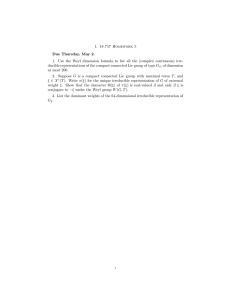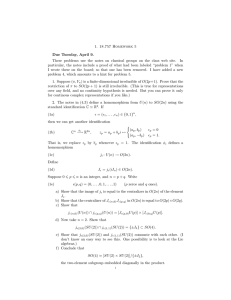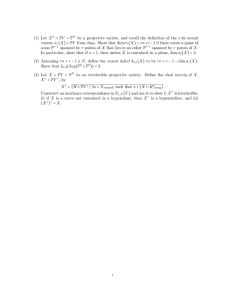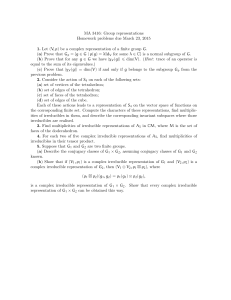Document 10553904
advertisement
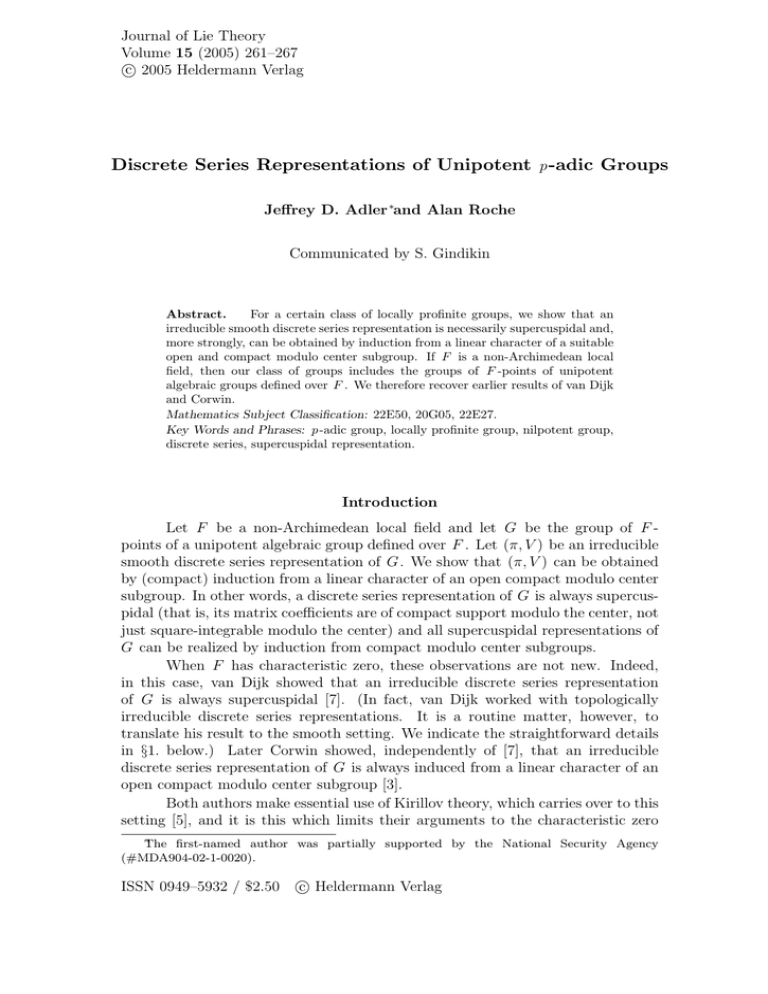
Journal of Lie Theory
Volume 15 (2005) 261–267
c 2005 Heldermann Verlag
Discrete Series Representations of Unipotent p -adic Groups
Jeffrey D. Adler ∗and Alan Roche
Communicated by S. Gindikin
Abstract.
For a certain class of locally profinite groups, we show that an
irreducible smooth discrete series representation is necessarily supercuspidal and,
more strongly, can be obtained by induction from a linear character of a suitable
open and compact modulo center subgroup. If F is a non-Archimedean local
field, then our class of groups includes the groups of F -points of unipotent
algebraic groups defined over F . We therefore recover earlier results of van Dijk
and Corwin.
Mathematics Subject Classification: 22E50, 20G05, 22E27.
Key Words and Phrases: p -adic group, locally profinite group, nilpotent group,
discrete series, supercuspidal representation.
Introduction
Let F be a non-Archimedean local field and let G be the group of F points of a unipotent algebraic group defined over F . Let (π, V ) be an irreducible
smooth discrete series representation of G. We show that (π, V ) can be obtained
by (compact) induction from a linear character of an open compact modulo center
subgroup. In other words, a discrete series representation of G is always supercuspidal (that is, its matrix coefficients are of compact support modulo the center, not
just square-integrable modulo the center) and all supercuspidal representations of
G can be realized by induction from compact modulo center subgroups.
When F has characteristic zero, these observations are not new. Indeed,
in this case, van Dijk showed that an irreducible discrete series representation
of G is always supercuspidal [7]. (In fact, van Dijk worked with topologically
irreducible discrete series representations. It is a routine matter, however, to
translate his result to the smooth setting. We indicate the straightforward details
in §1. below.) Later Corwin showed, independently of [7], that an irreducible
discrete series representation of G is always induced from a linear character of an
open compact modulo center subgroup [3].
Both authors make essential use of Kirillov theory, which carries over to this
setting [5], and it is this which limits their arguments to the characteristic zero
∗
The
first-named author was partially supported by the National Security Agency
(#MDA904-02-1-0020).
c Heldermann Verlag
ISSN 0949–5932 / $2.50 262
Adler and Roche
case (or, for suitable groups, to the case of sufficiently large positive characteristic).
In contrast, our approach is valid in all characteristics. Our arguments are completely elementary, and virtually trivial: they rely only on the Schur orthogonality
relations for matrix coefficients and some straightforward representation theory.
In addition, we use only a simple structural property of G as a locally profinite
group, namely that it can be written as a countable union of compact modulo
center subgroups, each one normal in the next. For such groups, we show that
each irreducible discrete series representation can be obtained by induction from
a suitable compact modulo center subgroup. When G is the group of F -points of
a unipotent algebraic group, it is easy to see further that such representations are
monomial, as G is then nilpotent as an abstract group.
We note that the results of this paper carry over trivially to the case in
which G = G(F ) with G a connected nilpotent algebraic group defined over F ,
as G is then the product of the F -points of a central torus in G and the F -points
of the unipotent radical of G.
Finally, we thank an anonymous referee for helpful comments.
1.
Smooth versus unitary discrete series
In this section, G denotes a separable unimodular locally profinite group.
We briefly recall some basic definitions and constructions. (Similar material is
treated, in somewhat more detail, in [2] §1.2.) This section is not needed in the
next. We include it only to clearly demonstrate that our main result fully contains
that of [7].
We write Z for the center of G. Let (π, V ) be a smooth irreducible
representation of G and write (π ∨ , V ∨ ) for the smooth dual or contragredient
of (π, V ). Since G is separable, (π, V ) admits a central character χ. We assume
that this character is unitary. Let v ∈ V, v ∨ ∈ V ∨ and set fv,v∨ (g) = hπ(g)v, v ∨ i,
g ∈ G, where, as usual, h , i denotes the canonical pairing. As χ is unitary,
|fv,v∨ | is a function on G/Z . Then (π, V ) is a discrete series representation if
|fv,v∨ | belongs to L2 (G/Z) for all v ∈ V, v ∨ ∈ V ∨ . It is easy to prove that an
irreducible smooth discrete series representation is admissible (that is, for each
open subgroup K of G, the space V K of K -fixed vectors is finite-dimensional).
This follows, for example, from a slight modification of the proof of a) ⇒ b) on
page 26 of [1] (which shows that a finitely generated smooth representation with
compactly supported matrix coefficients is admissible).
We next fix a Haar measure dġ on G/Z . Consider the space of, say,
continuous functions f : G → C such that
1. f (zg) = χ(z)f (g), for all z ∈ Z, g ∈ G,
R
2. G/Z |f (g)|2 dġ < ∞.
This carries the obvious inner product
Z
(f1 , f2 ) =
f1 (g)f2 (g) dġ.
G/Z
Of course, G acts on this space by right translations and the action preserves the
inner product. Suppose now that (π, V ) is a discrete series representation. Then,
Adler and Roche
263
for any non-zero v ∨ ∈ V ∨ , the non-zero map v 7→ fv,v∨ intertwines π with the
above action. It follows that (π, V ) admits a G-invariant inner product, which we
again denote by ( , ). Further, as (π, V ) is admissible, the inner product is unique
up to positive scalars. This leads to the following part of Schur orthogonality: there
is a positive scalar d(π), the formal degree of π , such that
Z
1
(π(g)v1 , w1 )(π(g)v2 , w2 ) dġ =
(v1 , v2 )(w1 , w2 ),
(1)
d(π)
G/Z
for all v1 , v2 , w1 , w2 ∈ V . If G/Z is compact, then (π, V ) has finite dimension and
d(π) is simply this dimension divided by the measure of G/Z .
Suppose next that (τ, H) is a unitary representation of G. Thus H is a
Hilbert space and, for all g ∈ G, τ (g) is a unitary operator on H such that, for
all u, v ∈ H ,
g 7→ (τ (g)u, v) : G → C
is continuous, where ( , ) now denotes the inner product on H . The representation
(τ, H) is irreducible if it is non-zero and has no non-trivial closed G-invariant
subspace. An irreducible unitary representation admits a central character. Then
(τ, H) is a discrete series representation if it is irreducible and if, for all u, v ∈ H ,
g 7→ |(τ (g)u, v)| belongs to L2 (G/Z).
A unitary discrete series representation is admissible (see, for example,
[4] Theorem 2).
We briefly recall the connection between the two notions of the discrete
series. We again let (π, V ) be an irreducible smooth discrete series representation
of G. We write Vb for the Hilbert space completion of V with respect to a Ginvariant inner product on V . Then the action of G on V via π extends to Vb to
yield a unitary representation (b
π , Vb ). Using the admissibility of (π, V ), it is easy
to check that this unitary representation is irreducible and hence discrete series.
In the other direction, let (τ, H) be a unitary (irreducible) discrete series
representation of G. Let H∞ denote the space of smooth vectors, that is, all
vectors fixed by some open subgroup of G. Then H∞ is G-invariant and so defines
a smooth representation (τ∞ , H∞ ) of G. Again, one checks readily, using the
admissibility of (τ, H), that (τ∞ , H∞ ) is (algebraically) irreducible. It is obviously
also a discrete series representation.
These procedures, (π, V ) 7→ (b
π , Vb ) and (τ, H) 7→ (τ∞ , H∞ ), are mutually
inverse, in the sense that Vb∞ ∼
= V in the category of smooth representations
∼
d
and H
H
in
the
category
of
unitary representations. They therefore induce
=
∞
bijections between the set of equivalence classes of smooth irreducible discrete
series representations of G and the set of equivalence classes of irreducible unitary
discrete series representations of G.
The paper [7] works in the unitary setting. Its main result is the following.
Let G be the group of F -points of a unipotent algebraic group defined over F ,
where F has characteristic zero, and let (τ, H) be an (irreducible) unitary discrete
series representation of G. Then for all u, v ∈ H∞ , the function g → (τ (g)u, v) has
compact support modulo Z . In the next section, we will prove a sharper version of
the analogous statement for an irreducible smooth discrete series representation, in
fact for a slightly wider class of groups. By the bijections above, van Dijk’s result
is a simple formal consequence of ours.
264
Adler and Roche
2.
Discrete series implies supercuspidal
We assume now that G contains a sequence of open subgroups (Ki ) such
that
1. each Ki contains the center Z of G and is compact modulo Z ;
2. Ki is normal in Ki+1 , for all i;
S
3. G = ∞
i=1 Ki .
We note first that the group of F -points of a unipotent algebraic group
defined over F always contains such a sequence. Indeed, any such group embeds
as a closed subgroup of some group USof unipotent upper triangular matrices. It
can therefore be expressed as a union ∞
i=1 Hi with each Hi an open and compact
modulo center subgroup such that Hi ⊂ Hi+1 for all i. Further, as U is nilpotent
as an abstract group, each Hi is nilpotent. Thus each subgroup of Hi is strictly
contained in its normalizer, for all i. Since [Hi : Hi−1 ] is finite (for i ≥ 2), it
follows that we can refine the sequence (Hi ) to obtain a sequence (Ki ) as above.
We now state the main result.
Theorem 2.1.
Let G be a locally profinite group as above and let (π, V ) be
an irreducible smooth discrete series representation of G. Then there is an open
compact modulo center subgroup K of G and an irreducible smooth representation
ρ of K such that π ∼
= ind G
K ρ.
Proof.
Fix a sequence of subgroups (Ki ) as above. Let ρ1 be an irreducible
component of π|K1 . For each i ≥ 2, we inductively choose an irreducible component ρi of π|Ki such that ρi |Ki−1 contains a subrepresentation isomorphic to
ρi−1 . Let mi denote the multiplicity of ρi in π|Ki . Further, for each irreducible
representation τ of Ki+1 , we write m(τ ) for the multiplicity of τ in π|Ki+1 and
[τ |Ki : ρi ] for the multiplicity of ρi in τ |Ki . By considering how the irreducible
components of π|Ki+1 restrict to Ki , we see that
mi =
X
m(τ ) [τ |Ki : ρi ]
τ
where the sum is over all irreducible components τ of π|Ki+1 . In particular,
mi ≥ mi+1 [ρi+1 |Ki : ρi ] ≥ mi+1 .
(2)
Thus (mi ) is a decreasing sequence of positive integers and so is eventually constant. Let m = limi→∞ mi and reindex the groups Ki , if necessary, so that mi = m
for all i ≥ 1. Of course, (2) then implies that
[ρi+1 |Ki : ρi ] = 1,
∀i.
(3)
Let ( , ) be a G-invariant inner product on V . For each i, we choose
a vector vi with (vi , vi ) = 1 such that vi generates an irreducible Ki -subspace
isomorphic to ρi . (Note that, having chosen v1 , we cannot choose all vi to be
265
Adler and Roche
equal to v1 because we do not (yet) know that v1 generates an irreducible Ki space.) We also fix a Haar measure dġ on G/Z . Of course, this restricts to a Haar
measure dk̇ on the open subgroup Ki /Z . Then
Z
Z
2
|(π(g)vi , vi )| dġ ≥
|(π(k)vi , vi )|2 dk̇.
G/Z
Ki /Z
Let d(π) denote the formal degree of (π, V ) and write |Ki /Z| for the measure of
Ki /Z (both with respect to dġ ). Then, since (vi , vi ) = 1, (1) and the succeeding
sentence imply that
|Ki /Z|
1
≥
.
d(π)
dim ρi
i /Z|
Thus the sequence ( |K
) is bounded above.
dim ρi
Consider the restriction ρi+1 |Ki . Clifford theory clearly applies in this
setting. It then follows from (3) that ρi+1 |Ki is multiplicity free. Further, if
fi = {y ∈ Ki+1 : y ρi ∼
we put K
= ρi }, then
ρi+1 |Ki ∼
=
M
y
ρi .
fi
y∈Ki+1 /K
Therefore
This divides
fi ] dim ρi .
dim ρi+1 = [Ki+1 : K
[Ki+1 : Ki ] dim ρi = [Ki+1 /Z : Ki /Z] dim ρi =
|Ki+1 /Z|
dim ρi ,
|Ki /Z|
and so there are positive integers Ni such that
|Ki+1 /Z|
|Ki /Z|
Ni =
,
dim ρi
dim ρi+1
∀i.
(4)
i /Z|
Since the sequence ( |K
) is bounded above, we deduce that it must eventually
dim ρi
be constant. We again reindex, if necessary, so that it is actually constant. Then
dim ρi =
|Ki /Z|
dim ρi−1 = [Ki : Ki−1 ] dim ρi−1 ,
|Ki−1 /Z|
∀i ≥ 2.
Hence
dim ρi = [Ki : K1 ] dim ρ1 ,
∀i ≥ 1,
and thus
i
ρi ∼
= indK
K1 ρ1 ,
∀i ≥ 1.
It follows that indG
K1 ρ1 is irreducible, since this is an increasing union of the
irreducible Ki -subspaces ρi . Since π|K1 contains ρ1 , there is a non-zero Gmap from ind G
K1 ρ1 to π . As both representations are irreducible, this map is
an isomorphism.
266
Adler and Roche
Remark 2.2.
Equation (4) is key to the above proof. We used Clifford theory
to deduce it from the multiplicity-one statement (3). With a slightly more involved
use of Clifford theory and some related notions, one can directly establish (4) and
so avoid the multiplicity considerations of the beginning of the proof.
Corollary 2.3.
Let (π, V ) be an irreducible smooth discrete series representation of G. Then (π, V ) is supercuspidal in the sense that all of its matrix
coefficients have compact support modulo Z .
Proof.
As a matrix coefficient of ρ extends (by zero) to a matrix coefficient of
π , it is clear that (π, V ) has at least one non-zero matrix coefficient, say fw,w∨ ,
that has compact support modulo Z . Now consider the space of all vectors v in V
such that fv,w∨ has compact support modulo Z . This is a non-zero G-subspace,
as it contains w . It therefore equals V .
Since (π, V ) is irreducible and admissible, its smooth dual (π ∨ , V ∨ ) is again
irreducible. For each v ∈ V , we consider the space of vectors v ∨ ∈ V ∨ such that
fv,v∨ has compact support modulo Z . By the preceding paragraph, this space
contains w∨ and so is non-zero, and hence equals V ∨ . This completes the proof.
Remark 2.4.
The proof shows that if an irreducible admissible representation
has one matrix coefficient that has compact support (or is square-integrable)
modulo the center, then all coefficients have this property. In the absence of
admissibility, this implication no longer holds (for a general locally profinite group).
For example, the group consisting of the matrices in GL2 (F ) with second row (0 1)
has trivial center and admits an irreducible smooth representation such that some,
but not all, matrix coefficients have compact support.
Suppose now that the group K in the statement of Theorem 2.1 is supersolvable. Then the irreducible smooth representation ρ of K is necessarily
monomial, that is, is induced from a linear character of a closed (equivalently,
open) subgroup. (This follows from the proof of the corresponding fact for irreducible representations of a supersolvable finite group. See, for example, [6] §8.5.)
Now if G is the group of F -points of a unipotent algebraic group defined over F ,
then G is nilpotent as an abstract group, whence its subgroup K is also nilpotent,
and so, a fortiori, supersolvable. We can therefore slightly refine Theorem 2.1 in
this case and, in particular, recover the main result of [3].
Corollary 2.5.
Let G be the group of F -points of a unipotent algebraic group
defined over F . Let (π, V ) be an irreducible smooth discrete series representation
of G. Then there is an open compact modulo center subgroup H of G and a linear
character λ of H such that π ∼
= ind G
H λ.
Adler and Roche
267
References
[1]
[2]
[3]
[4]
[5]
[6]
[7]
Bernstein, I. N., and A. V. Zelevinsky, Representations of the group
GL(n, F ) where F is a non-Archimedean local field , Russian Math. Surveys 31:3 (1976), 1-68.
Bushnell, C. J., G. Henniart, and P. C. Kutzko, Towards an explicit
Plancherel theorem for reductive p-adic groups, Preprint, 2000.
Corwin, L., Inducing “supercuspidal” representations of unipotent p-adic
groups from compact-mod-center subgroups, Compositio Math. 84 (1992),
no. 1, 85-89.
Harish-Chandra, Harmonic Analysis on reductive p-adic groups. Notes by
G. van Dijk, Lecture Notes in Mathematics, Vol. 162, Springer-Verlag,
Berlin-New York, 1970.
Moore, C. C., Decomposition of unitary representations defined by discrete
subgroups of nilpotent groups, Ann. of Math. (2) 82 (1965), 146-182.
Serre, J.-P., Linear representations of finite groups. Translated from the
second French edition by Leonard L. Scott, Graduate Texts in Mathematics, Vol. 42, Springer-Verlag, New York-Heidelberg, 1977.
van Dijk, G., Square-integrable repesentations mod Z of unipotent groups,
Compositio Math. 29 (1974), 141-150.
Jeffrey D. Adler
Department of Theoretical and Applied Mathematics
The University of Akron
Akron, OH 44325-4002
adler@uakron.edu
Received June 6, 2004
and in final form September 25, 2004
Alan Roche
Department of Mathematics
University of Oklahoma
Norman, OK 73019-0315
aroche@math.ou.edu
